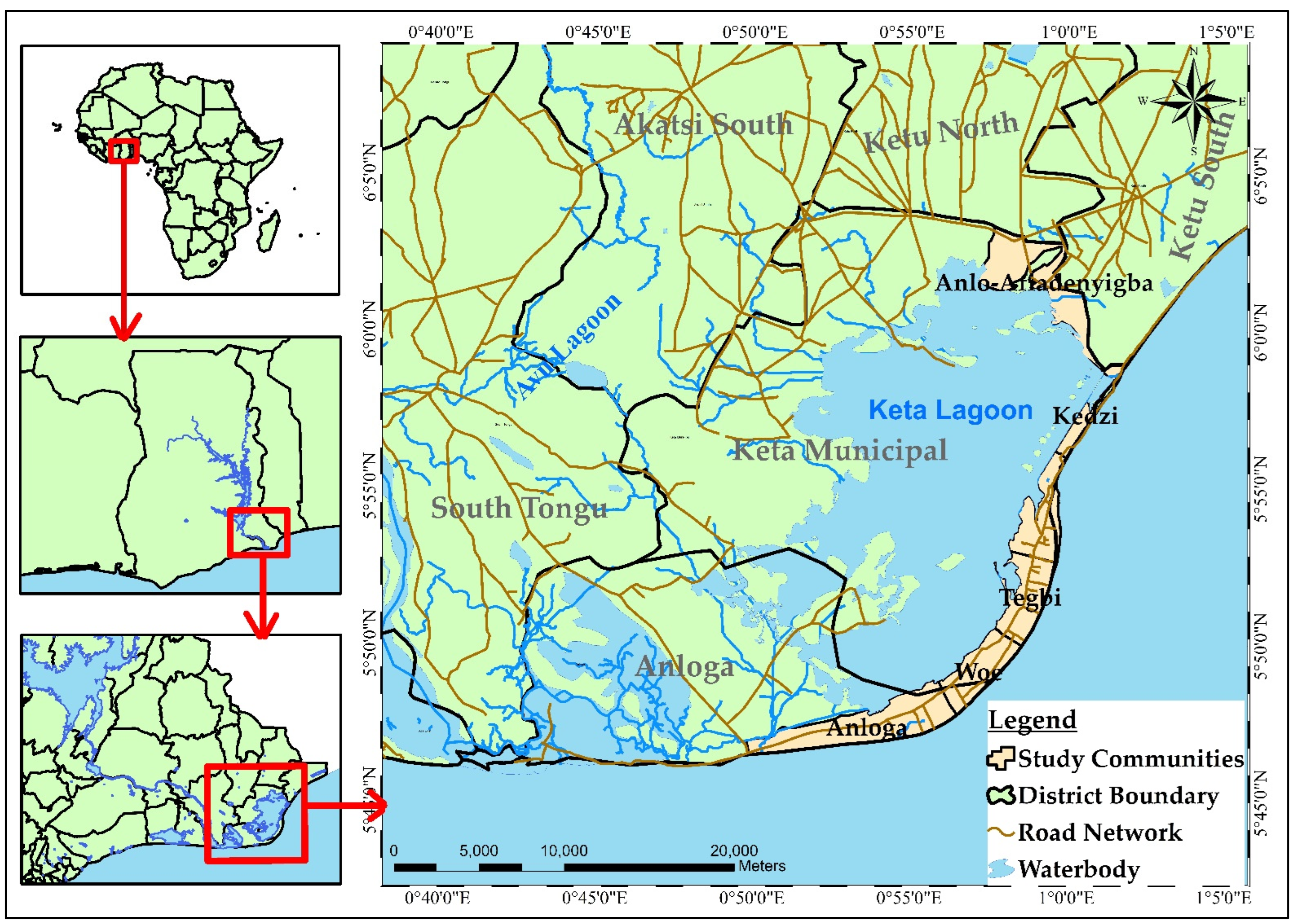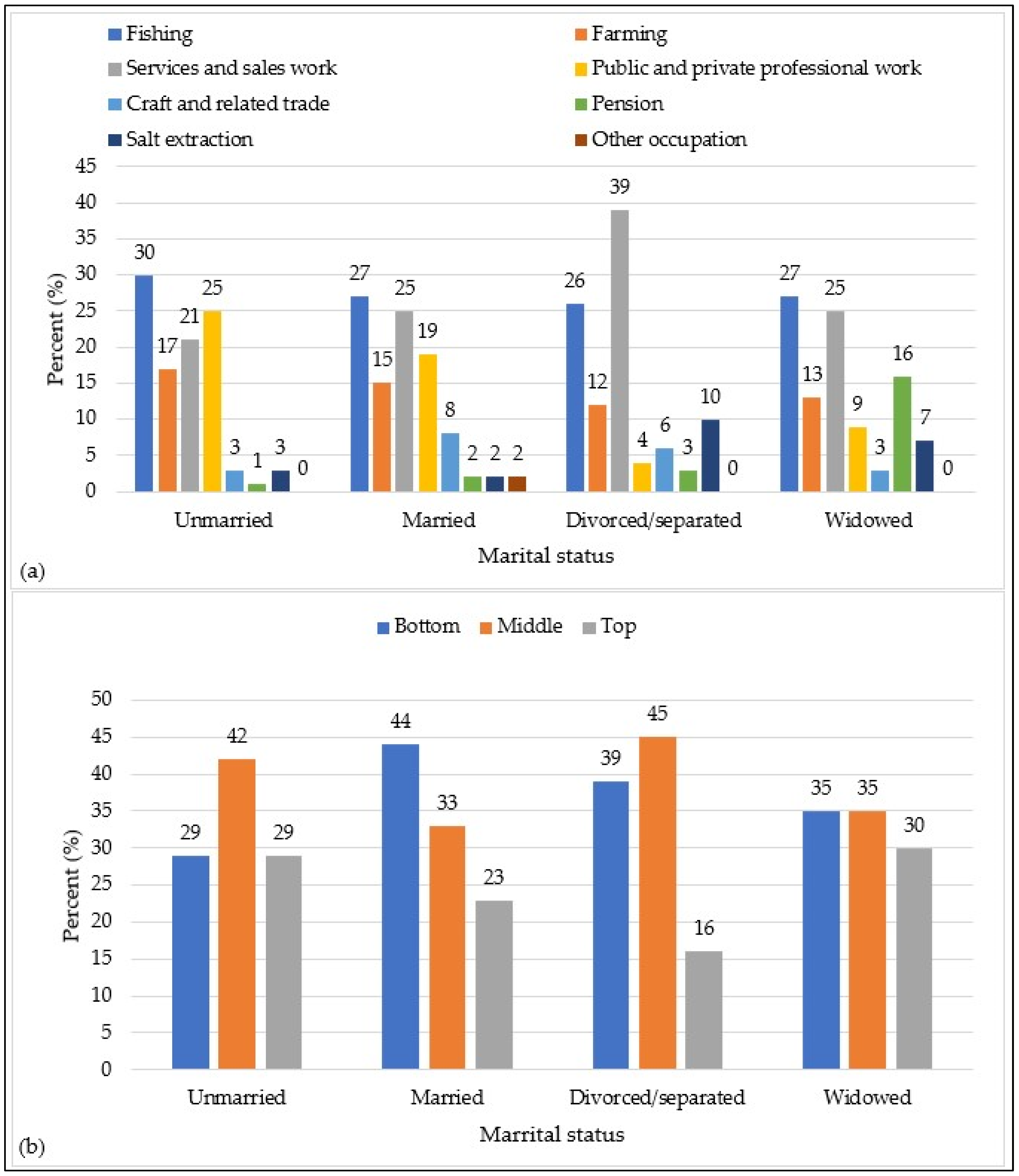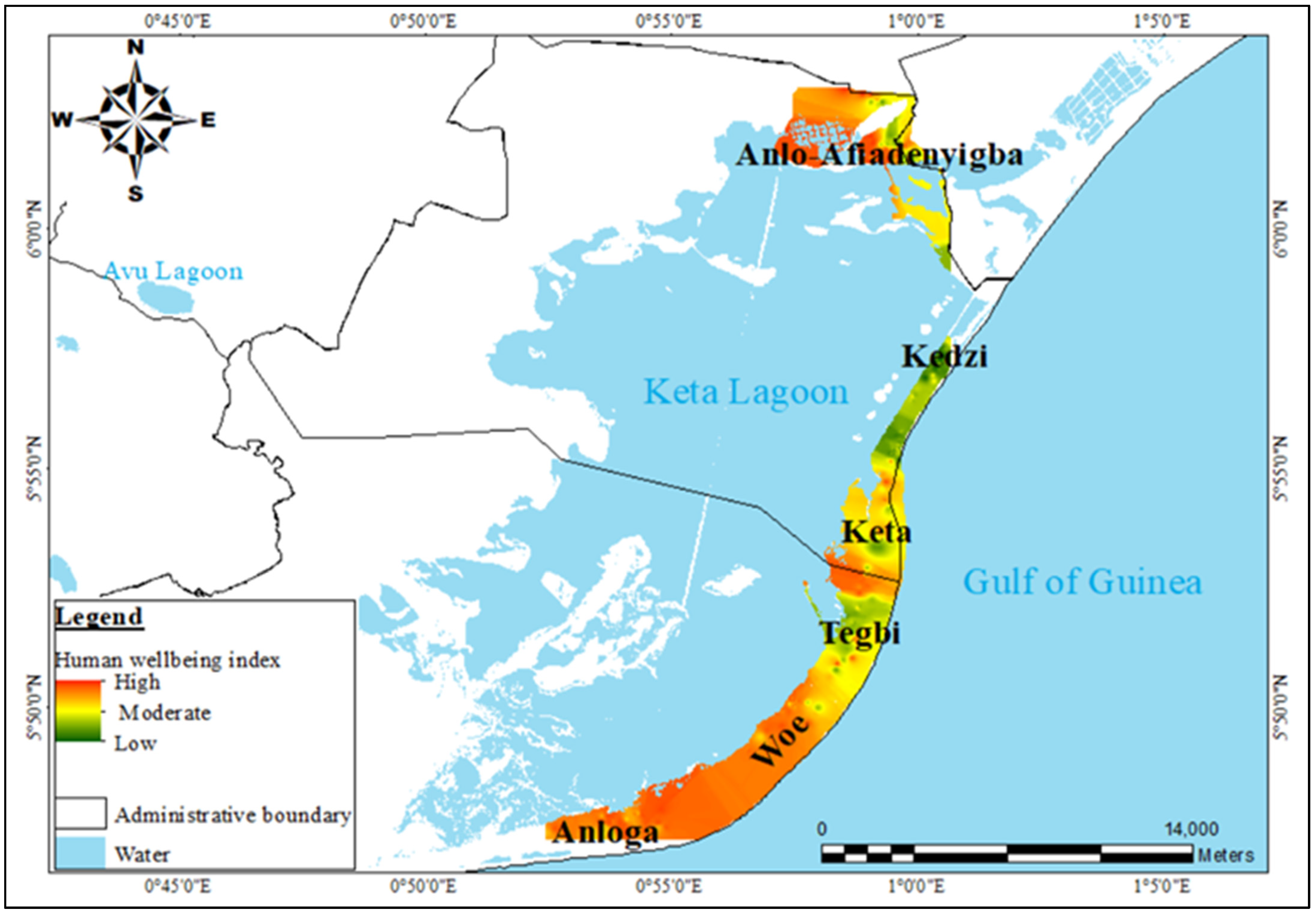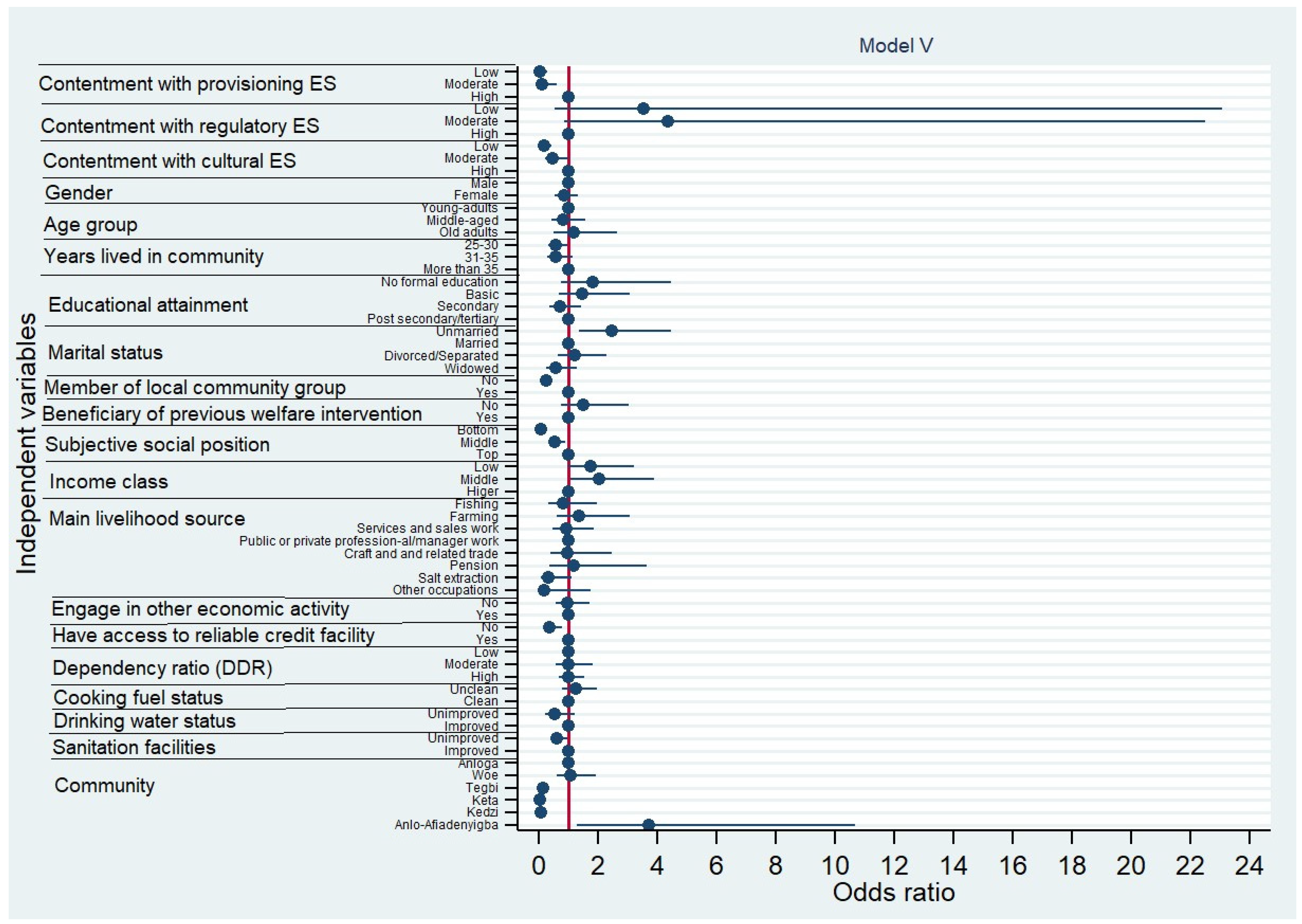Understanding the Complexities of Human Well-Being in the Context of Ecosystem Services within Coastal Ghana
Abstract
:1. Introduction
2. Materials and Methods
2.1. Study Area
2.2. Research Design and Study Population
2.3. Research Instrument and Measurement Items
2.4. Statistical Analysis
3. Results
3.1. Respondents’ Background Characteristics and Well-Being Levels
3.2. Univariate Analyses of the Association between Well-Being Levels of Respondents and Explanatory Variables
3.3. Sequential Logistic Regression Analysis of the Effects of ESs and Other Explanatory Variables on Respondents’ Well-Being
4. Discussion
5. Strengths, Limitations, and Future Research
6. Conclusions
Supplementary Materials
Author Contributions
Funding
Institutional Review Board Statement
Informed Consent Statement
Data Availability Statement
Acknowledgments
Conflicts of Interest
References
- Finlayson, C.M.; Cruz, R.D.; Davidson, N.; Alder, J.; Cork, S.; De Groot, R.S.; Milton, G.R.; Peterson, G.; Pritchard, D.; Ratner, B.D. Millennium Ecosystem Assessment: Ecosystems and Human Well-Being: Wetlands and Water Synthesis; Island Press: Washington, DC, USA, 2005. [Google Scholar]
- Mukherjee, K.; Pal, S. Hydrological and landscape dynamics of floodplain wetlands of the Diara region, Eastern India. Ecol. Indic. 2021, 121, 106961. [Google Scholar] [CrossRef]
- Ramsar Convention on Wetlands. Global Wetland Outlook: State of the World’s Wetlands and Their Services to People; Ramsar Convention Secretariat: Gland, Switzerland, 2018. [Google Scholar]
- Avornyo, S.Y. Water Quality Assessment of Some Coastal Lagoons in Ghana; LAP Lambert Academic Publishing: Chisinau, Moldova, 2019. [Google Scholar]
- Mwakaje, A.G. Wetlands, livelihoods, and sustainability in Tanzania. Afr. J. Ecol. 2009, 47, 179–184. [Google Scholar] [CrossRef]
- Kankam, S.; Inkoom, J.N.; Koo, H.; Fürst, C. Envisioning alternative futures of cultural ecosystem services supply in the coastal landscapes of Southwestern Ghana, West Africa. Socio-Ecol. Pract. Res. 2021, 3, 309–328. [Google Scholar] [CrossRef]
- Zahir, I.L.M.; Nijamir, K. Application of Geospatial Technology for Wetlands’ Mapping and Change-Detection: A Case Study in Selected Areas of South Eastern Coast in Ampara District, Sri Lanka. Sustain. Geosci. Geotour. 2018, 1, 25–32. [Google Scholar] [CrossRef]
- Ma, C.; Zhang, G.Y.; Zhang, X.C.; Zhao, Y.J.; Li, H.Y. Application of Markov model in wetland change dynamics in Tianjin Coastal Area, China. Procedia Environ. Sci. 2012, 13, 252–262. [Google Scholar] [CrossRef]
- Zhang, X.; Wang, G.; Xue, B.; Zhang, M.; Tan, Z. Dynamic landscapes and the driving forces in the Yellow River Delta wetland region in the past four decades. Sci. Total Environ. 2021, 787, 147644. [Google Scholar] [CrossRef]
- Scoones, I. Sustainable rural livelihoods: A framework for analysis. J. Peasant Stud. 1999, 42, 171–196. [Google Scholar] [CrossRef]
- Lamsal, P.; Pant, K.P.; Kumar, L.; Atreya, K. Sustainable livelihoods through conservation of wetland resources: A case of economic benefits from Ghodaghodi Lake, western Nepal. Ecol. Soc. 2015, 20, 10. [Google Scholar] [CrossRef]
- MA. Ecosystems and Human Well-being: Synthesis; Island Press: Washington, DC, USA, 2005. [Google Scholar]
- Bhatta, L.D.; Ning, W.; Udas, E.; Agrawal, N.K.; Ranabhat, S.; Basnet, D. Wetlands in the Himalaya: Securing Services for Livelihoods (Issue March); International Centre for Integrated Mountain Development (ICIMOD): Patan, Nepal, 2018. [Google Scholar]
- Li, X.; Bellerby, R.; Craft, C.; Widney, S.E. Coastal wetland loss, consequences, and challenges for restoration. Anthr. Coasts 2018, 1, 1–15. [Google Scholar] [CrossRef]
- Kumi, J.A.; Kumi, M.A.; Apraku, A. Threats to the conservation of wetlands in Ghana: The case of Songor Ramsar site. J. Sci. Res. Rep. 2015, 6, 13–25. [Google Scholar] [CrossRef]
- Busch, M.; Gee, K.; Burkhard, B.; Lange, M.; Stelljes, N. Conceptualizing the link between marine ecosystem services and human well-being: The case of offshore wind farming. Int. J. Biodivers. Sci. Ecosyst. Serv. Manag. 2011, 7, 190–203. [Google Scholar] [CrossRef]
- Pereira, E.; Queiroz, C.; Pereira, H.M.; Vicente, L. Ecosystem services and human well-being: A participatory study in a mountain community in Portugal. Ecol. Soc. 2005, 10, 14. [Google Scholar] [CrossRef]
- Yang, W.; Dietz, T.; Kramer, D.B.; Chen, X.; Liu, J. Going Beyond the Millennium Ecosystem Assessment: An Index System of Human Well-Being. PLoS ONE 2013, 8, e64582. [Google Scholar] [CrossRef] [PubMed]
- Huang, Q.; Yin, D.; He, C.; Yan, J.; Liu, Z.; Meng, S. Linking ecosystem services and subjective well-being in rapidly urbanizing watersheds: Insights from a multilevel linear model. Ecosyst. Serv. 2020, 43, 101106. [Google Scholar] [CrossRef]
- Costanza, R.; Kubiszewski, I.; Giovannini, E.; Lovins, H.; Mcglade, J.; Pickett, K.E. Development: Time to leave gdp behind. Nature 2014, 505, 283–285. [Google Scholar] [CrossRef]
- Haines-Young, H.R.; Potschin-Young, B.M. The Links Between Biodiversity, Ecosystem Services and Human Well-Being. In Ecosystem Ecology: A New Synthesis; Raffaelli, D., Frid, C., Eds.; Cambridge University Press: Cambridge, UK, 2010; pp. 110–139. [Google Scholar] [CrossRef]
- McGregor, A.; Coulthard, S.; Camfield, L. Measuring What Matters: The Role of Well-Being Methods in Development Policy and Practice. 2015. Available online: https://odi.org/en/publications/measuring-what-matters-the-role-of-well-being-methods-in-development-policy-and-practice/ (accessed on 12 January 2022).
- Hong, S.; Lee, S.; Jo, H.; Yoo, M. Impact of Frequency of Visits and Time Spent in Urban Green Space on Subjective Well-Being. Sustainability 2019, 11, 4189. [Google Scholar] [CrossRef]
- Kaplan, R.; Kaplan, S. The Experience of Nature: A Psychological Perspective; Cambridge University Press: Cambridge, UK, 1989. [Google Scholar]
- Diener, E.; Wirtz, D.; Biswas-diener, R.; Tov, W.; Kim-prieto, C.; Choi, D.; Oishi, S. New Measures of Well-Being. In Assessing Well-Being; Springer: Dordrecht, The Netherlands, 2009. [Google Scholar] [CrossRef]
- Egoh, B.N.; Farrell, P.J.O.; Charef, A.; Gurney, L.J.; Koellner, T.; Nibam, H.; Egoh, M.; Willemen, L. An African account of ecosystem service provision: Use, threats and policy options for sustainable livelihoods. Ecosyst. Serv. 2012, 2, 71–81. [Google Scholar] [CrossRef]
- Hagedoorn, L.; Kinney, K.; van Beukering, P.; Adzah, S.; Koetse, M.; Commodore, T.; Addo, K.A.; Apom, B.; Simons, H.; Kamstra, J. Economic Valuation of Ecosystem Services at the Ghanaian Coast. 2020. Available online: https://www.researchgate.net/publication/345980513_Economic_valuation_of_ecosystem_services_at_the_Ghanaian_coast/stats (accessed on 11 January 2022).
- Duku, E.; Mattah, P.A.D.; Angnuureng, D.B. Assessment of Land Use/Land Cover Change and Morphometric Parameters in the Keta Lagoon Complex Ramsar Site, Ghana. Water 2021, 13, 2537. [Google Scholar] [CrossRef]
- Brinks, R.J. Sustainable Tourism Development in the Keta Lagoon Complex Ramsar Site, Ghana; Utrecht University: Utrecht, The Netherlands, 2017. [Google Scholar]
- Tabachnick, B.G.; Fidell, L.S. Using Multivariate Statistics, 6th ed.; Pearson: London, UK, 2012. [Google Scholar]
- Ntiamoa-Baidu, Y.; Piersma, T.; Wiersma, P.; Poot, M.; Battley, P.; Gordon, C. Water depth selection, daily feeding routines and diets of waterbirds in coastal lagoons in Ghana. Ibis 1998, 140, 89–103. [Google Scholar] [CrossRef]
- Tufour, K. Keta Lagoon Complex Ramsar Site Management Plan; Ghana Wildlife Division: Accra, Ghana, 1999; Available online: https://rsis.ramsar.org/RISapp/files/21565097/documents/GH567_mgt1508.pdf (accessed on 15 January 2021).
- Keta Municipal Assembly. Comprehensive Annual Report on Projects and Programmes Implemented in 2016; Keta Municipal Assembly: Keta, Ghana, 2017.
- Adler, N.E.; Epel, E.S.; Castellazzo, G.; Ickovics, J.R. Relationship of Subjective and Objective Social Status with Psychological and Physiological Functioning: Preliminary Data in Healthy White Women. Health Psychol. 2000, 19, 586–592. [Google Scholar] [CrossRef]
- Nemoto, T.; Beglar, D. Developing Likert-scale questionnaires. In Proceedings of the JALT 2013 Conference, Kobe, Japan, 25–28 October 2013; pp. 1–8. [Google Scholar]
- Bryce, R.; Irvine, K.N.; Church, A.; Fish, R.; Ranger, S.; Kenter, J.O. Subjective well-being indicators for large-scale assessment of cultural ecosystem services. Ecosyst. Serv. 2016, 21, 258–269. [Google Scholar] [CrossRef]
- Hori, J.; Makino, M. The structure of human well-being related to ecosystem services in coastal areas: A comparison among the six North Pacific countries. Mar. Policy 2018, 153, 382–387. [Google Scholar] [CrossRef]
- McMichael, A.; Scholes, R.; Hefny, M.; Pereira, E.; Palm, C.; Foale, S. Linking Ecosystem Services and Human Well-Being. Available online: https://www.millenniumassessment.org/documents/document.341.aspx.pdf (accessed on 20 December 2021).
- Pedersen, E.; Weisner, S.E.B.; Johansson, M. Wetland areas’ direct contributions to residents’ well-being entitles them to high cultural ecosystem values. Sci. Total Environ. 2019, 646, 1315–1326. [Google Scholar] [CrossRef] [PubMed]
- Song, M.; Huntsinger, L.; Han, M. How does the Ecological Well-Being of Urban and Rural Residents Change with Rural-Urban Land Conversion? The case of Hubei, China. Sustainability 2018, 10, 527. [Google Scholar] [CrossRef]
- Mcmahan, E.A.; Dixon, K.J.; King, L.M. Evidence of Associations between Lay Conceptions and Experienced Well-Being. J. Happiness Stud. 2013, 14, 655–671. [Google Scholar] [CrossRef]
- Armah, F.A.; Ekumah, B.; Yawson, D.O.; Odoi, J.O.; Afitiri, A.-R.; Nyieku, F.E. Access to improved water and sanitation in sub-Saharan Africa in a quarter century. Heliyon 2018, 4, e00931. [Google Scholar] [CrossRef]
- Hadley, C.; Belachew, T.; Lindstrom, D.; Tessema, F. The Shape of Things to Come ? Household Dependency Ratio and Adolescent Nutritional Status in Rural and Urban Ethiopia. Am. J. Phys. Anthropol. 2011, 144, 643–652. [Google Scholar] [CrossRef]
- Mara, D.; Lane, J.; Scott, B.; Trouba, D. Sanitation and Health. PLoS Med. 2010, 7. [Google Scholar] [CrossRef]
- Iddrisu, A.; Seidu, A.; Duku, E.; Frimpong, J.B. Risk factors associated with the coexistence of stunting, underweight, and wasting in children under 5 from 31 Saharan African countries. BMJ Open 2021, 11, e052267. [Google Scholar] [CrossRef]
- Fuller, J.A.; Westphal, J.A.; Kenney, B.; Eisenberg, J.N.S. The joint effects of water and sanitation on diarrhoeal disease: A multicounty analysis of the Demographic and Health Surveys. Trop. Med. Int. Health 2015, 20, 284–292. [Google Scholar] [CrossRef]
- Butler, C.D.; Oluoch-Kosura, W. Linking future ecosystem services and future human well-being. Ecol. Soc. 2006, 11, 30. [Google Scholar] [CrossRef]
- Raudsepp-Hearne, C.; Peterson, G.D.; Teng, M.; Bennett, E.M.; Holland, T.; Benessaiah, K.; MacDonald, G.K.; Pfeifer, L. Untangling the environmentalist’s paradox: Why is human well-being increasing as ecosystem services degrade? BioScience 2010, 60, 576–589. [Google Scholar] [CrossRef]
- Hossain, M.S.; Eigenbrod, F.; Johnson, F.A.; Dearing, J.A. Unravelling the interrelationships between ecosystem services and human wellbeing in the Bangladesh delta. Int. J. Sustain. Dev. World Ecol. 2017, 24, 120–134. [Google Scholar] [CrossRef]
- Santos-Martın, F.; Martin-Lopez, B.; Garcıa-Llorente, M.; Aguado, M.; Benayas, J.; Montes, C. Unraveling the Relationships between Ecosystems and Human Wellbeing in Spain. PLoS ONE 2013, 8, e73249. [Google Scholar] [CrossRef]
- Rendón, O.R.; Garbutt, A.; Skov, M.; Möller, I.; Alexander, M.; Ballinger, R.; Wyles, K.; Smith, G.; Mckinley, E.; Griffin, J.; et al. A framework linking ecosystem services and human well-being Saltmarsh as a case study. People Nat. 2019, 1, 486–496. [Google Scholar] [CrossRef]
- Leviston, Z.; Walker, I.; Green, M.; Price, J. Linkages between ecosystem services and human wellbeing: A Nexus Webs approach. Ecol. Indic. 2018, 93, 658–668. [Google Scholar] [CrossRef]
- Yang, W.; Dietz, T.; Liu, W.; Luo, J.; Liu, J. Going Beyond the Millennium Ecosystem Assessment: An Index System of Human Dependence on Ecosystem Services. PLoS ONE 2013, 8, e64581. [Google Scholar] [CrossRef] [PubMed]
- Yeboah, T.; Egyir, I. Forms, Prevalence and Drivers of Children’s Work and Children’s Harmful Work in Shallot Production on the Keta Peninsula, South-Eastern Ghana (No. 2; Issue November). 2020. Available online: https://opendocs.ids.ac.uk/opendocs/bitstream/handle/20.500.12413/15760/ACHA_Working_Paper_2.pdf?sequence=1&isAllowed=y (accessed on 12 January 2022).
- Mahama, T.A.-K.; Nkegbe, P.K. Impact of household livelihood diversification on welfare in Ghana. Sci. Afr. 2021, 13, e00858. [Google Scholar] [CrossRef]
- World Bank. World Development Report 2006: Equity and Development. World Bank. 2005. Available online: https://openknowledge.worldbank.org/handle/10986/5988 (accessed on 20 December 2021).
- Addai, I.; Opoku-Agyeman, C.; Amanfu, S.K. Marriage and Subjective Well-being in Ghana. Afr. Rev. Econ. Financ. 2015, 7, 53–79. [Google Scholar]
- Lamptey, E. Marital Status and Health Outcomes in a Developing Country: Exploring the Contextual Effects of Marriage, Gender, Children, and Lineal Ties on Subjective Health in Ghana. Ph.D. Thesis, University of Akron, Akron, OH, USA, 2017. [Google Scholar]
- Porter, G.; Lyon, F. Groups as a means or an end? Social capital and the promotion of cooperation in Ghana. Environment and Planning Development. Soc. Space 2006, 24, 249–263. [Google Scholar] [CrossRef]
- Jennings, V.; Bamkole, O. The Relationship between Social Cohesion and Urban Green Space: An Avenue for Health Promotion. Int. J. Environ. Res. Public Health 2019, 16, 452. [Google Scholar] [CrossRef] [PubMed]
- Liu, Y.; Wang, R.; Grekousis, G.; Liu, Y.; Yuan, Y.; Li, Z. Neighbourhood greenness and mental wellbeing in Guangzhou, China: What are the pathways? Landsc. Urban Plan. 2019, 190, 103602. [Google Scholar] [CrossRef]
- Liu, Y.; Wang, R.; Xiao, Y.; Huang, B.; Chen, H.; Li, Z. Exploring the linkage between greenness exposure and depression among Chinese people: Mediating roles of physical activity, stress and social cohesion and moderating role of urbanicity. Health Place 2019, 58, 102168. [Google Scholar] [CrossRef]
- Ma, B.; Zhou, T.; Lei, S.; Wen, Y.; Theint, T. Effects of urban green spaces on residents’ well-being. Environ. Dev. Sustain. 2018, 21, 2793–2809. [Google Scholar] [CrossRef]
- Goldman, N.; Cornman, J.C. Measuring Subjective Social Status: A Case Study of Older Taiwanese. J. Cross-Cult. Gerontol. 2006, 21, 71–89. [Google Scholar] [CrossRef] [PubMed]
- Operario, D.; Adler, N.E.; Williams, D.R. Subjective social status: Reliability and predictive utility for global health. Psychol. Health 2004, 19, 237–246. [Google Scholar] [CrossRef]
- Ejrnæs, A.; Greve, B. Your position in society matters for how happy you are. Int. J. Soc. Welf. 2016, 26, 206–217. [Google Scholar] [CrossRef]
- Bartram, J.; Lewis, K.; Lenton, R.; Wright, A. Focusing on improved water and sanitation for health. Lancet 2005, 365, 810–812. [Google Scholar] [CrossRef]
- WHO. WHO Water, Sanitation and Hygiene Strategy 2018–2025. 2018. Available online: https://apps.who.int/iris/handle/10665/274273 (accessed on 15 November 2021).
- Gimelli, F.M.; Bos, J.J.; Rogers, B.C. Fostering equity and wellbeing through water: A reinterpretation of the goal of securing access. World Dev. 2018, 104, 1–9. [Google Scholar] [CrossRef]
- Keighren, I.M.; Holloway, R. Environmental Determinism. In International Encyclopedia of Social & Behavioral Sciences; Elsevier: Amsterdam, The Netherlands, 2015; Volume 7. [Google Scholar] [CrossRef]
- Meyer, W.B.; States, U. Environmental Determinism. In International Encyclopedia of Human Geography, 2nd ed.; Elsevier: Amsterdam, The Netherlands, 2005; Volume 4. [Google Scholar] [CrossRef]
- Duku, E.; Agbeko, P.; Mattah, D.; Bapentire, D. Assessment of wetland ecosystem services and human wellbeing nexus in sub-Saharan Africa: Empirical evidence from a socio-ecological landscape of Ghana. Environ. Sustain. Indic. 2022, 15, 100186. [Google Scholar] [CrossRef]
- Ramsar Convention Secretariat. The Fourth Ramsar Strategic Plan 2016–2024. RAMSAR Handbooks for the Wise Use of Wetlands, 5th ed.; Ramsar Convention Secretariat: Gland, Switzerland, 2016. [Google Scholar]




| Variables | n | % | Variables | N | % |
|---|---|---|---|---|---|
| Gender | Engage in other economic activity | ||||
| Male | 502 | 63 | No | 707 | 88 |
| Female | 292 | 37 | Yes | 92 | 12 |
| Age group | Member of local community group | ||||
| Young adults: <35 years | 153 | 20 | No | 213 | 27 |
| Middle-aged adults: 35–55 | 443 | 56 | Yes | 581 | 73 |
| Old-aged adults: >55 years | 192 | 24 | |||
| Years lived in community | Residential status | ||||
| 25–30 | 294 | 37 | Indigene | 731 | 92 |
| 31–35 | 75 | 9 | Migrant | 61 | 8 |
| More than 35 | 425 | 54 | SSP | ||
| Educational level | Bottom | 317 | 40 | ||
| No formal education | 188 | 24 | Middle | 285 | 36 |
| Basic | 296 | 37 | Top | 192 | 24 |
| Secondary | 176 | 22 | Dependency ratio (DDR) | ||
| Post-secondary | 134 | 17 | Low | 372 | 47 |
| Religious Affiliation | Middle | 120 | 16 | ||
| Christian | 474 | 59 | High | 292 | 37 |
| Traditionalist | 150 | 19 | Beneficiary of previous welfare intervention | ||
| Islamic | 21 | 3 | No | 680 | 86 |
| Do not belong | 149 | 19 | Yes | 114 | 14 |
| Marital status | Income class | ||||
| Unmarried | 146 | 18 | Low (<GHC 700) | 383 | 48 |
| Married | 511 | 64 | Middle (GHC 700–999) | 145 | 18 |
| Divorced/separated | 69 | 9 | High (>GHC 999) | 266 | 34 |
| Widowed | 68 | 9 | Access to a reliable credit facility | ||
| Main livelihood source | No | 705 | 89 | ||
| Fishing | 217 | 27 | Yes | 89 | 11 |
| Farming | 119 | 15 | Cooking fuel status | ||
| Services and sales work | 199 | 25 | Unclean | 441 | 56 |
| Public or private professional/manager work | 144 | 18 | Clean | 353 | 44 |
| Craft and related trade | 49 | 6 | Drinking water status | ||
| Salt extraction | 28 | 3 | Unimproved | 50 | 6 |
| Pension | 26 | 4 | Improved | 744 | 94 |
| Other occupations | 12 | 2 | Sanitation facilities | ||
| Unimproved | 486 | 61 | |||
| Improved | 308 | 39 |
| Human Well-Being Levels | ||||
|---|---|---|---|---|
| Variable | Low Well-Being | Moderate Well-Being | High Well-Being | Chi-Square |
| % | % | % | ||
| Gender | ||||
| Male | 45 | 17 | 38 | = 10.507 *, Cramer’s V = 0.115 |
| Female | 36 | 26 | 38 | |
| Age group | ||||
| Young adults | 29 | 30 | 41 | = 21.822 *, Cramer’s V = 0.117 |
| Middle-aged adults | 46 | 20 | 34 | |
| Old-aged adults | 42 | 14 | 44 | |
| Residence status | ||||
| Indigene | 42 | 20 | 38 | = 3.948, Cramer’s V = 0.071 |
| Migrant | 30 | 27 | 43 | |
| Years lived in community | ||||
| 25–30 | 54 | 20 | 26 | = 39.068 ***, Cramer’s V = 0.157 |
| 31–35 | 40.0 | 27 | 33 | |
| More than 35 | 33 | 20 | 47 | |
| Religious affiliation | ||||
| Christian | 43 | 20 | 37 | = 8.171, Cramer’s V = 0.072 |
| Traditional | 45 | 17 | 38 | |
| Islamic | 19 | 38 | 43 | |
| Do not belong | 38 | 21 | 41 | |
| Educational level | ||||
| No formal education | 37 | 15 | 48 | = 19.798 *, Cramer’s V = 0.112 |
| Basic | 43 | 20 | 37 | |
| Secondary | 49 | 22 | 29 | |
| Post-secondary | 35 | 27 | 38 | |
| Marital status | ||||
| Unmarried | 19 | 21 | 60 | = 74.080 ***, Cramer’s V = 0.216 |
| Married | 50 | 21 | 29 | |
| Divorced/separated | 29 | 26 | 45 | |
| Widowed | 37 | 7 | 56 | |
| Dependency ratio | ||||
| Low | 31 | 24 | 45 | = 29.603 ***, Cramer’s V = 0.137 |
| Moderate | 47 | 18 | 35 | |
| High | 52 | 17 | 32 | |
| Income class | ||||
| Low | 49 | 13 | 38 | = 44.491 ***, Cramer’s V = 0.167 |
| Middle | 40 | 19 | 41 | |
| High | 31 | 33 | 36 | |
| Main livelihood source | ||||
| Fishing | 57 | 13 | 30 | = 66.730 ***, Cramer’s V = 0.205 |
| Farming | 26 | 20 | 54 | |
| Services and sales work | 38 | 29 | 33 | |
| Public or private professional/manager work | 40 | 23 | 37 | |
| Craft and related trade | 35 | 28 | 37 | |
| Salt extraction | 23 | 8 | 69 | |
| Pension | 36 | 11 | 53 | |
| Other occupations | 75 | 8 | 17 | |
| Engage in other economic activity | ||||
| No | 42 | 20 | 38 | = 2.426, Cramer’s V = 0.055 |
| Yes | 36 | 26 | 38 | |
| Beneficiary of previous welfare intervention | ||||
| No | 40 | 19 | 41 | = 18.318 ***, Cramer’s V = 0.152 |
| Yes | 53 | 27 | 20 | |
| Member of local community group | ||||
| No | 38 | 15 | 47 | = 77.843 ***, Cramer’s V = 0.313 |
| Yes | 52 | 34 | 14 | |
| SSP | ||||
| Bottom | 75 | 16 | 9 | = 274.004 ***, Cramer’s V = 0.415 |
| Middle | 24 | 19 | 57 | |
| Top | 13 | 29 | 58 | |
| Access to a reliable credit facility | ||||
| No | 45 | 17 | 38 | = 52.666 ***, Cramer’s V = 0.258 |
| Yes | 15 | 47 | 38 | |
| Cooking fuel status | ||||
| Unclean | 39 | 18 | 44 | = 7.8504 *, Cramer’s V = 0.0994 |
| Clean | 45 | 24 | 31 | |
| Drinking water status | ||||
| Unimproved | 72 | 8.0 | 20 | = 20.665 ***, Cramer’s V = 0.161 |
| Improved | 39 | 22 | 39 | |
| Sanitation facilities | ||||
| Unimproved | 46 | 21 | 33 | = 12.540 *, Cramer’s V = 0.126 |
| Improved | 34 | 18 | 47 | |
| Contentment with PESs | ||||
| Low | 61 | 15 | 24 | = 170.371 ***, Cramer’s V = 0.328 |
| Moderate | 18 | 28 | 54 | |
| High | 0 | 7 | 93 | |
| Contentment with RESs | ||||
| Low | 61 | 6 | 33 | |
| Moderate | 27 | 30.0 | 43 | = 120.622 ***, Cramer’s V = 0.276 |
| High | 72 | 16 | 12 | |
| Contentment with CESs | ||||
| Low | 64 | 8 | 28 | = 172.661 ***, Cramer’s V = 0.313 |
| Moderate | 18 | 34 | 48 | |
| High | 45 | 15 | 40 | |
| Community | ||||
| Anloga | 1 | 36 | 63 | = 429.488 ***, Cramer’s V = 0.501 |
| Woe | 0 | 37 | 63 | |
| Tegbi | 75 | 4 | 21 | |
| Keta | 67 | 18 | 15 | |
| Kedzi | 77 | 23 | 0.0 | |
| Anlo-Afiadenyigba | 29 | 5 | 67 | |
Publisher’s Note: MDPI stays neutral with regard to jurisdictional claims in published maps and institutional affiliations. |
© 2022 by the authors. Licensee MDPI, Basel, Switzerland. This article is an open access article distributed under the terms and conditions of the Creative Commons Attribution (CC BY) license (https://creativecommons.org/licenses/by/4.0/).
Share and Cite
Duku, E.; Mattah, P.A.D.; Angnuureng, D.B.; Adotey, J. Understanding the Complexities of Human Well-Being in the Context of Ecosystem Services within Coastal Ghana. Sustainability 2022, 14, 10111. https://doi.org/10.3390/su141610111
Duku E, Mattah PAD, Angnuureng DB, Adotey J. Understanding the Complexities of Human Well-Being in the Context of Ecosystem Services within Coastal Ghana. Sustainability. 2022; 14(16):10111. https://doi.org/10.3390/su141610111
Chicago/Turabian StyleDuku, Eric, Precious Agbeko Dzorgbe Mattah, Donatus Bapentire Angnuureng, and Joshua Adotey. 2022. "Understanding the Complexities of Human Well-Being in the Context of Ecosystem Services within Coastal Ghana" Sustainability 14, no. 16: 10111. https://doi.org/10.3390/su141610111








